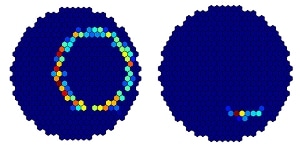Mar 6 2017
A new citizen science project, led by astronomers at the University of Minnesota, is asking for help from the public to identify and categorize hundreds of thousands of ring patterns within images produced by VERITAS gamma-ray observatory cameras.
 On the left is an example of a complete muon ring that is fully contained in the camera. Astronomers use these to calibrate their telescopes. Unfortunately, sometimes researchers only get an image of an incomplete ring, which can look similar to images of gamma rays. (Credit: VERITAS Collaboration)
On the left is an example of a complete muon ring that is fully contained in the camera. Astronomers use these to calibrate their telescopes. Unfortunately, sometimes researchers only get an image of an incomplete ring, which can look similar to images of gamma rays. (Credit: VERITAS Collaboration)
The goal of the project, named Muon Hunter, is to help distinguish ring-like images produced by elementary particles, called muons (think of them as the electron's heavier cousin), from patterns produced by gamma rays that the telescope is designed to detect. The information is essential for astronomers to ensure that telescopes are working properly.
To get started, visit the Muon Hunter website at muonhunters.org.
The project is run by Zooniverse, the largest online platform for collaborative volunteer research, in conjunction with the (Very Energetic Radiation Imaging Telescope Array System) VERITAS Collaboration, a group of astronomers from around the world. Citizen science projects allow researchers to efficiently and effectively comb through large amounts of complex data using the enthusiastic efforts of millions of volunteers around the world. Due to unique cognitive abilities, humans still outperform computers. Other Zooinverse projects include searching for planets and decoding Civil War documents.
“This is a really exciting project for me because I've been involved in both VERITAS and Zooniverse for nearly a decade,” said University of Minnesota Physics and Astronomy Associate Professor Lucy Fortson, co-founder of Zooniverse and VERITAS researcher. “I've wanted to bring the cool science of gamma ray astronomy to the crowd for some time. Muon Hunters is our first foray, and I'm really looking forward to seeing what interesting things the crowd discovers in the data.”
In this project, the participants become “muon hunters” helping to find elusive muons disguised as gamma rays. Gamma rays are the most energetic radiation in the universe, and scientists study them to explore the most exotic and extreme processes and physical conditions. Gamma rays offer astronomers a new window into the universe.
Muons produce distinctive ring-shaped images in the telescope cameras. If astronomers get a good image of a ring it can be very useful. The diameter of the ring is related to how bright it appears. By detecting lots of rings, scientists can use them to check that their telescopes are working properly. If one day the muon rings all appear brighter or dimmer than they should for their diameter, then that tells astronomers that something is wrong.
However, these rings are not all good. If researchers only get an incomplete ring in the camera, then it can look more like a filled-in elongated oval. Unfortunately, this is the shape that astronomers are looking for to detect gamma-ray showers. The computer finds it very difficult to tell the difference between a small part of a ring and a filled oval.
This is where citizen scientists come in. By identifying and measuring the properties of these partial rings, the public can help astronomers to reduce the background and also provide more images to calibrate the telescopes. In the future, astronomers can use the images that citizen scientists have identified to better train the computer programs to automatically tell the difference between the image types.
The VERITAS Collaboration, a group of more than 100 astronomers from the United States, Canada, Ireland, and Germany, operates a major ground-based gamma-ray observatory located in southern Arizona. VERITAS comprises an array of four, 12-meter optical reflectors for gamma-ray astronomy.
While the data for Muon Hunters comes from the VERITAS telescope, the team involved in the citizen science experiment is led by the University of Minnesota and incorporates scientists and educators from the specific VERITAS institutions including University of California-Los Angeles; University of California-Santa Cruz; McGill University, Canada; Deutsches Electron-Synchrotron Laboratory, Berlin, Germany; Barnard College/Columbia University; Cal State University - East Bay; and Harvard-Smithsonian Center for Astrophysics.